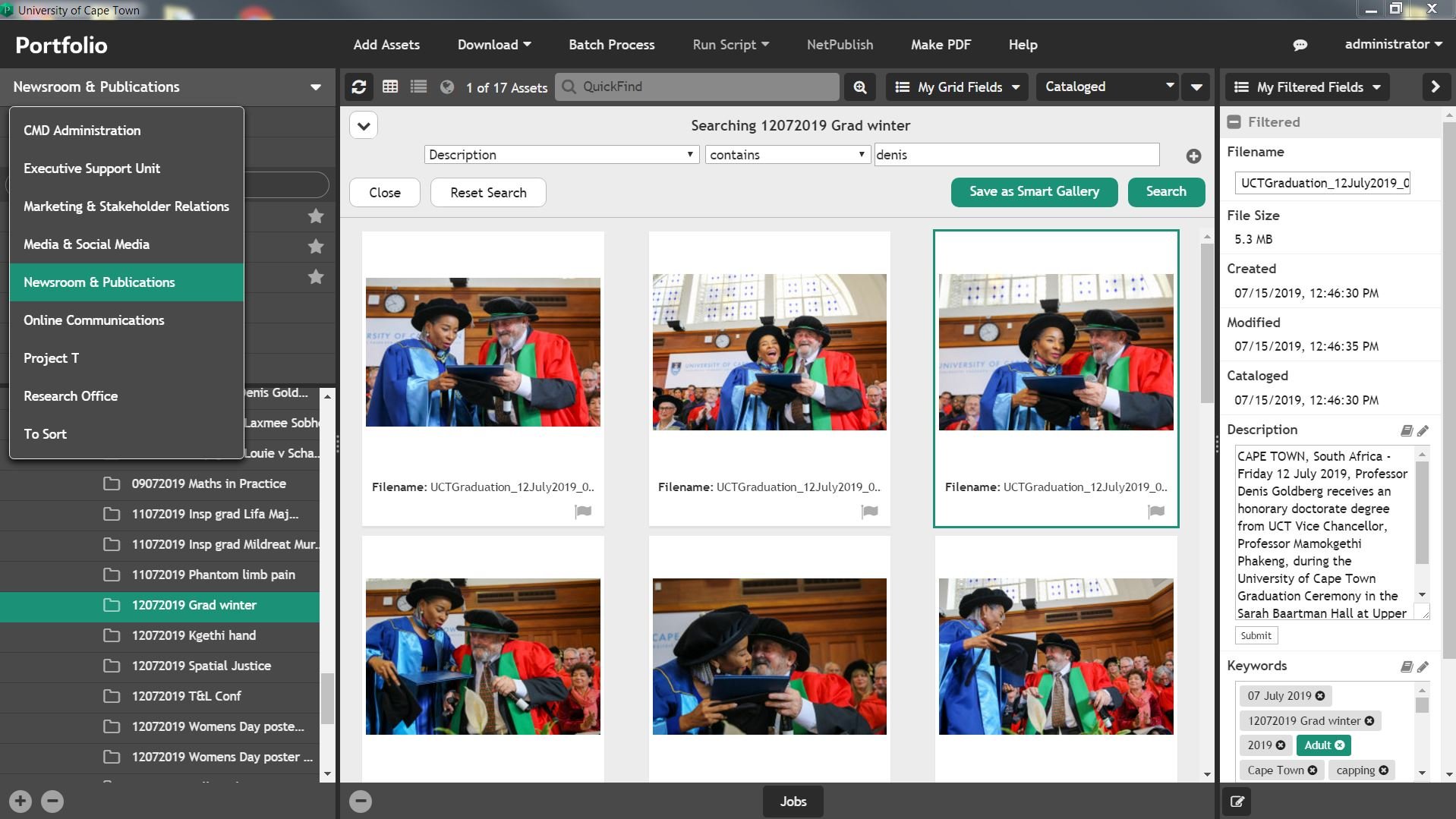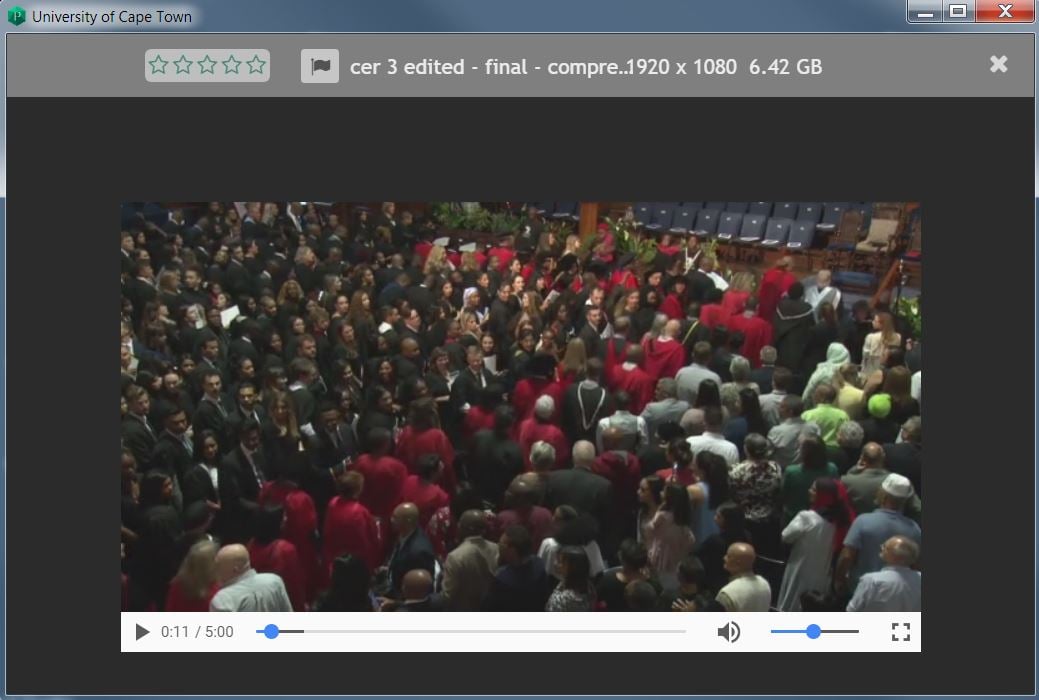Control the chaos and unleash your team's potential with Extensis Connect / Learn More
Control the chaos and unleash your team's potential with Extensis Connect / Learn More

Having trouble managing multiple departments, multiple professionals, and thousands of digital assets?
Sound familiar?
Many educational institutions face myriad challenges around managing digital assets. Creating a structured folder hierarchy while maintaining rules and logic can be very difficult. Human logic can change day-to-day and multiple users will always want to save files into different folders and name assets in ways that might be difficult for colleagues to locate at a later stage.
We spoke with Nico Badenhuizen, senior PHP developer at the University of Cape Town (UCT), to find out how easy it was to implement Extensis Portfolio, our digital asset management (DAM) solution, and how it has helped to overcome UCT's daily challenges.
E: Hi Nico. Thank you for joining us. Could you start by letting us know more about the university?
N: Thanks for having me. UCT started in 1829 as a high school for boys. Today, our research-led university serves approximately 33,000 people, with around 28,700 students, and 4,900 permanent staff across six academic faculties.

We are the leading university in Africa (according to Times Higher Education World University Rankings, Quacquarelli Symonds World University Rankings, and the Centre for World University Rankings) thanks to the excellence of our research and our focus on the teaching and learning experience. We believe that becoming the best university on the continent depends on embracing diversity and ensuring inclusivity, which means that everyone in our community feels at home and can achieve their full potential.
E: What are your responsibilities at UCT?
N: I am the senior PHP developer in the Communication and Marketing Department (CMD), which employs roughly 45 communication professionals. The department serves the entire university, with our responsibilities extending across academic faculties, administrative departments, the offices of the registrar, and the vice-chancellor, specifically in terms of broader marketing, news-related activities, and internal campus communication.
One of the responsibilities of my role is to look after the assets used on the university’s four websites: main, students, staff, and news. I’m also responsible for research into and implementation of proprietary software in CMD, which includes DAM.
E: Can you tell us a bit more about how a DAM solution became a necessity for the university?
N: In the past, our primary storage facility was a network share and by 2017 we were starting to battle with the structure, usability, and expansion of that space. CMD generates an enormous amount of content on a daily basis, particularly when it comes to video and photos. So storage capacity has always been a big concern. In addition to this, a lot of CMD assets were spread between our different units – newsroom and multimedia, media and social media, marketing and stakeholder relations, and online communications – which made it very difficult to locate specific pieces of content. We didn’t even know that some of our older content existed!
It became clear in 2017 that our assets actually had very little value because we didn’t have a clear picture of all the assets we had. And the assets we were familiar with were very difficult to find unless you were the owner of that content. So, looking for a DAM solution became an operational necessity.
The need to acquire a DAM solution was particularly driven by the newsroom and multimedia units, which produce an enormous quantity of digital content, including video and photography. I think the volume of content we create nowadays is far greater than we produced 10 (or even five) years ago. Storage requirements are increasing exponentially every year.
E: Besides storage space, were there any other problems that CMD was struggling with?
N: Over the years, our various users saved items into their own folder systems, so it became almost impossible to make the most of each asset’s value across the department. Assets were also being copied and saved into several different folders, depending on individual unit requirements, which meant that we were wasting space through duplication. In addition to this, because everyone had full access to everything in the network share, folders were easily moved around or deleted, making it unmanageable.
It was just really difficult for colleagues to retrieve a specific piece of content unless they knew who had created and stored it in the first place! This only increased in complexity with a team of 45 professionals with differing demands. While some of our photographers captured relevant metadata in the programs that they used (Adobe Photoshop, for example), others didn’t capture any metadata, so it always took a long time to find exactly what we were looking for.
These ongoing issues clearly needed to be addressed, so we started investigating DAM solutions. A year later we had implemented Extensis Portfolio and that is what we are still using today.
E: What made you decide to go with Extensis Portfolio?
N: We were looking for something simple. I have implemented software solutions before and I have found that user adoption can become very difficult. So, one of our key requirements was finding something that was relatively simple and intuitive for our users. It had to be something that wasn’t too far removed from what they were already working with.
I only had to sit through one or two demos before making the decision to buy the Portfolio software. It offered functionality that made the system easy to use from the user’s point of view. That was very attractive to me, along with the pricing. That’s why we chose it!

E: How was your implementation process?
N: I went through many CDs, DVDs, shared volumes, external hard drives, our primary shared drives, and more. In the first month, I migrated about 250,000 assets. I found that sorting assets in Portfolio was easier than trying to do it at folder level on my PC and it was really easy to set up the different Portfolio catalogues. I would copy assets into a Portfolio watch folder, sort it all out, and then move each asset to the correct Portfolio catalogue.
One other thing I really liked when migrating content into Portfolio was the ability to import metadata from a file’s path while retaining existing folder names. We often had full file names, so our file path and file names were quite complete. I just had to pick the full path and all the names inside each file folder parent to have them added as keyword metadata to an asset. That feature within the Portfolio solution proved invaluable for making the migration quick and easy. It’s something that works very well.
Creating accounts for our 45 team members was also quick and I took the opportunity to meet with each user for a short 15-minute one-to-one session to show them the software and how easy it was to use.
E: How is CMD currently using Portfolio?
N: Each unit has its own catalogue and we have created separate catalogues for each of our special projects. We all have read access to one another’s catalogues and full access to each of the unit catalogues.
Our marketing and stakeholder relations unit, for example, often needs both past and present photos of the same asset when they run a campaign. With Portfolio, they can quickly and easily find what they are looking for, rather than having to ask someone in another unit to search for them, which was the case for a very long time.
If one person is responsible for the assets – how they’re stored, named, and referenced – they soon get to know where everything is. If multiple people try to manage the assets, it becomes confusing very quickly. Enabling all the CMD units to search for the assets themselves has really helped.
Our media unit and our executive support unit both use Portfolio’s vault function because some of the content they manage is sensitive. With the vault function, only they have access to those assets and they don’t have to worry about sensitive information getting into the wrong hands.
Ensuring access to a machine that is 100% secure can be a concern. The vault is attractive because it secures and encrypts content, which keeps content safe and makes life easier.” - Nico Badenhuizen, Senior PHP Developer, University of Cape Town
E: How have CMD users responded to this change to a DAM solution?
N: Although I’m the administrator of Portfolio, I’m also a user. I haven’t had any complaints with the software or problems using the search functionality, which is in itself a very good thing. I regularly check up on the people who are creating folders and sub-folders, the colleagues who are actually using the system on a regular basis. I recommend this to maintain some sort of order and consistency in the folder hierarchy.
With regards to user feedback, some users were initially skeptical about storing large video files in the system. But they were pleasantly surprised that they could add large .mov files without compressing them! Also, some of the users really like the quick previews on videos. If you have a lot of videos, scrolling through them can be a nightmare. The short video previews that Portfolio creates really helps.

One other positive comment was about Portfolio’s ability to work in a cross-platform environment. We use both Mac and Windows systems and the feedback I’ve had so far is that the DAM solution simply works regardless of the operating system.
E: Can you briefly compare the before and after with regards to implementing a DAM?
N: Assets are definitely more accessible to everyone now. I can’t give you exact numbers but I think that in some cases our digital assets are 100% more accessible because they are actually in a place where they can be found, rather than on an external drive that has been forgotten about. Not having to worry so much about storage space has also been a big difference between the before and after.
E: Looking forward, are there any plans to use Portfolio across the university?
N: Our department is a good case study for the rest of the university because a lot of what we do can be replicated by other units and faculties. We have been using it very successfully for over a year now and the hope is that we see an uptake of the software into the academic faculties and administrative departments. I have already given access to some departments so they can start making use of the environment we have created.
As with many universities, Nico’s story highlights not only the need to effectively manage storage of and access to valuable content, but also the benefits from cross-department collaboration. Often, highly structured and compartmentalized organisations end up working in silos, ignoring the opportunities that different teams, working together, can bring.

Catarina Mendes – International Marketing Specialist
Catarina has been working in marketing and communication roles for over 10 years. At Extensis, she works closely with the EMEA Sales Team as well as Extensis network of Partners across Europe and Asia Pacific. Born and bred in Portugal she has been working in the U.K. for a little over 6 years. When she isn’t working she enjoys long walks in the countryside, cinema and books.